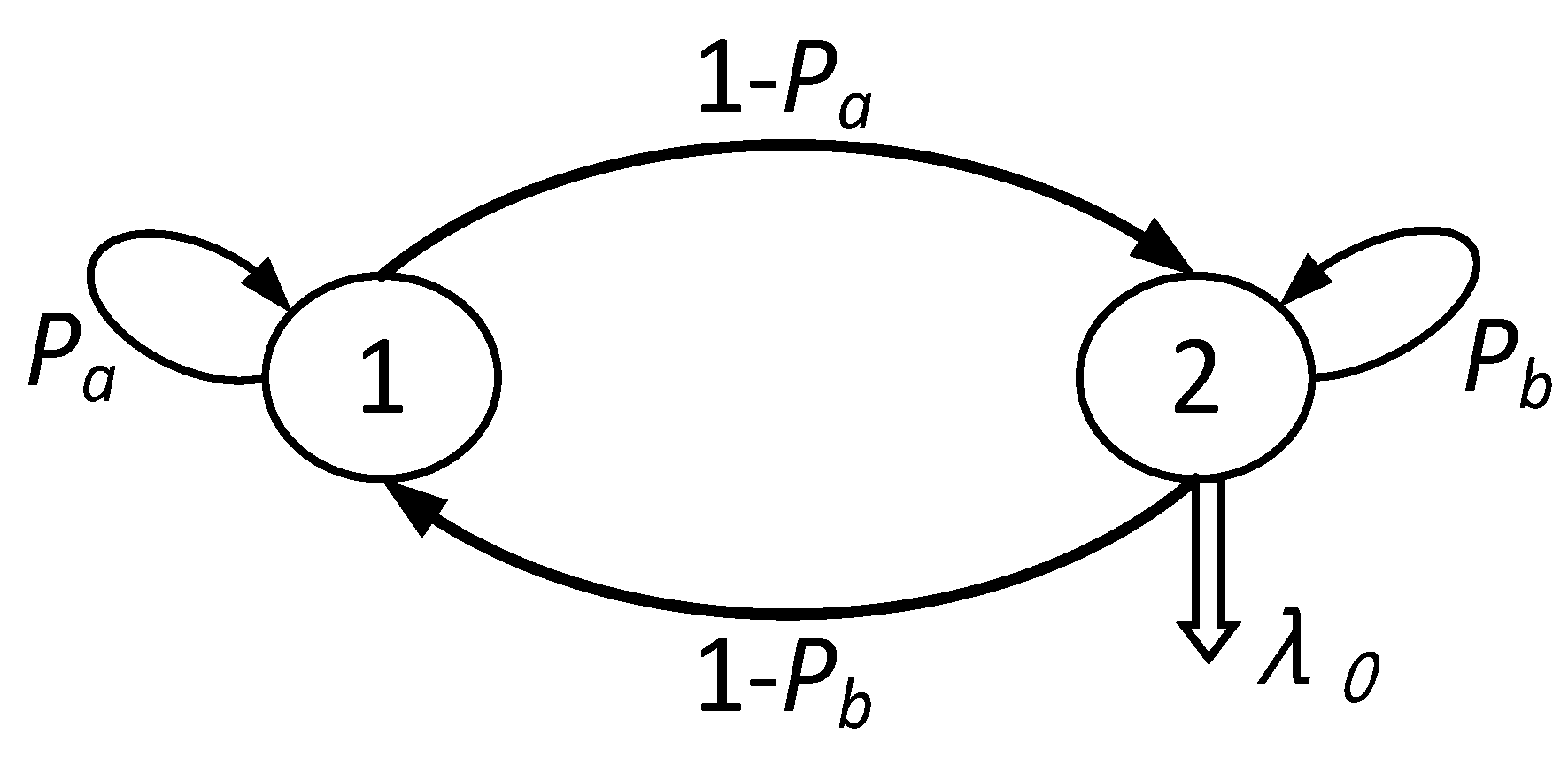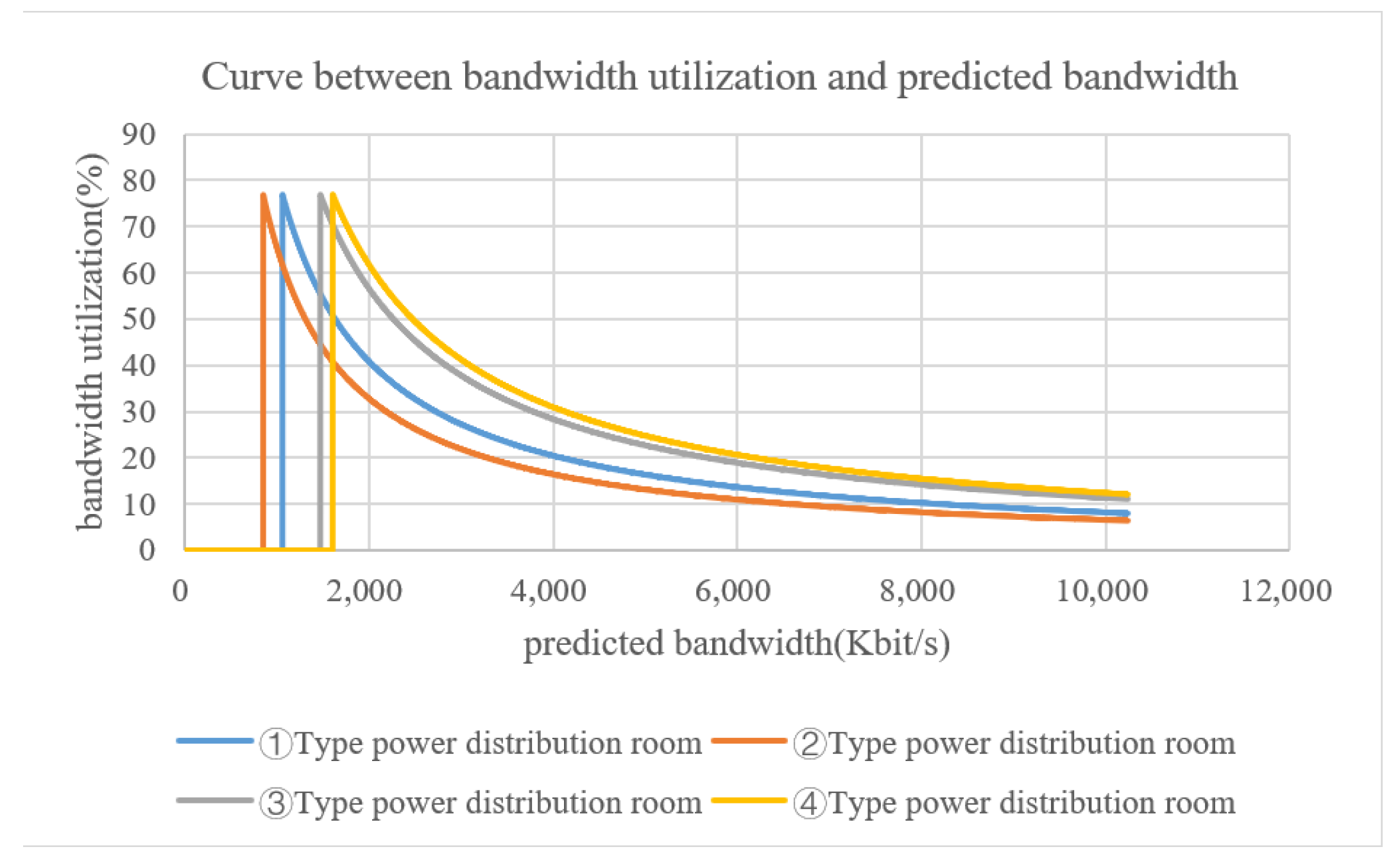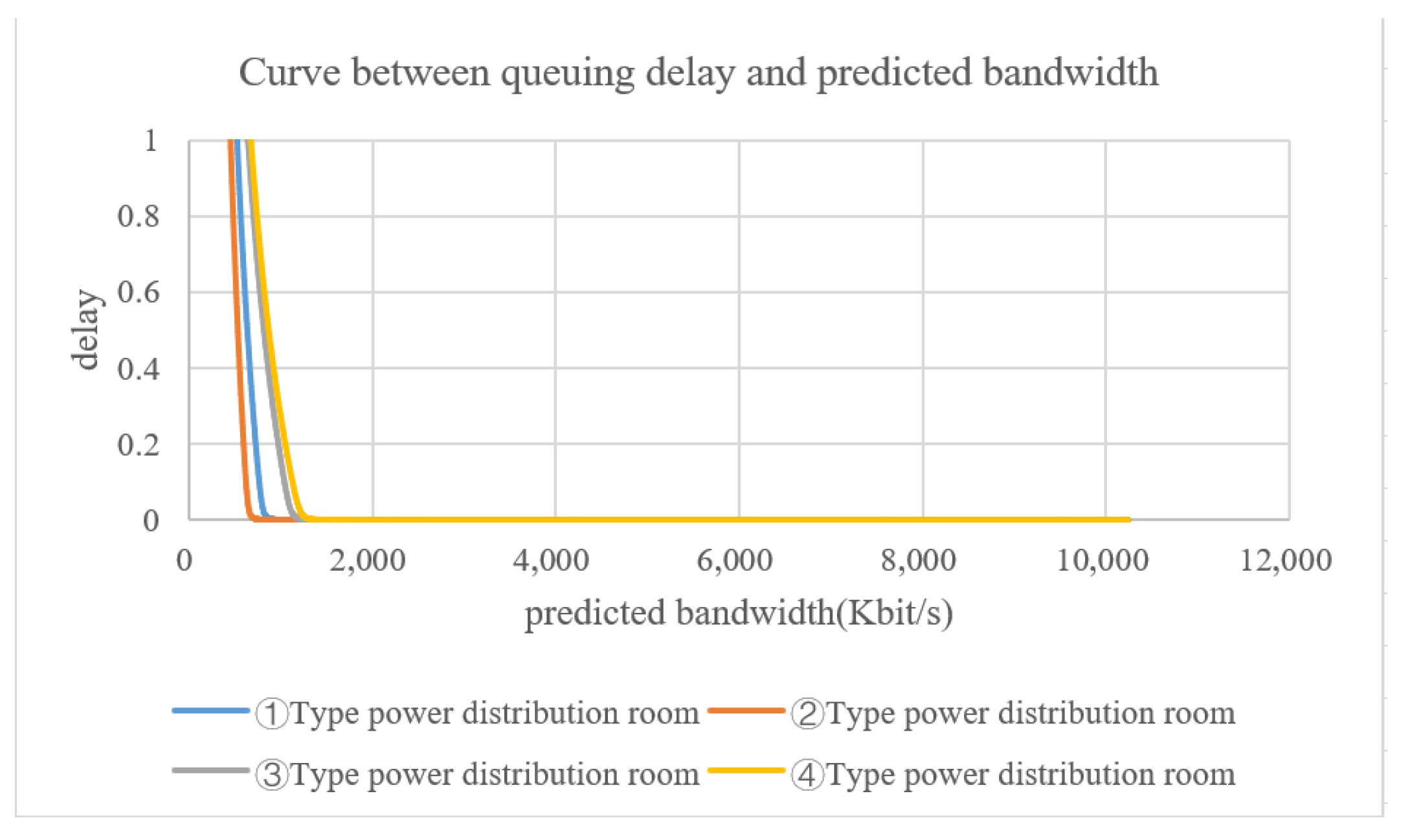Communication Bandwidth Prediction Technology for Smart Power Distribution Business in Smart Parks
Abstract
:1. Introduction
2. Convergence Flow Characteristics of Communication Services in Smart Parks
2.1. Basic Characteristics of Smart Park Communication Services
2.2. Analysis of Convergence Flow Characteristics of Communication Services in Smart Parks
3. Communication Bandwidth Estimation Model and Solution Method Based on MMPP/m/c/n Queue
3.1. Mixed Service Arrival Rate Model
3.2. Active Cache Management Mechanism
3.3. Performance Index Analysis and QoS Parameter Mapping Model
3.4. Solution of Bandwidth Prediction Model for Power Distribution Communication Service
4. Analysis of Calculation Examples of Communication Service Bandwidth Prediction
4.1. Reliability Experiment and Analysis of Bandwidth Prediction Model
4.2. Example Analysis of Bandwidth Prediction Optimization Model
5. Conclusions
Author Contributions
Funding
Data Availability Statement
Conflicts of Interest
References
- Quelhas, A.; Gil, E.; Mccalley, J.D.; Ryan, S.M. A multiperiod generalized network flow model of the U.S. integrated energy system: Part I—model description. IEEE Trans. Power Syst. 2007, 22, 829–836. [Google Scholar] [CrossRef]
- Colak, I.; Sagiroglu, S.; Fulli, G.; Yesilbudak, M. A survey on the critical issues in smart grid technologies. Renew. Sustain. Energy Rev. 2016, 54, 396–405. [Google Scholar] [CrossRef]
- Quelhas, A.; McAlley, J.D. A Multiperiod Generalized Network Flow Model of the U.S. Integrated Energy System: Part II—Simulation Results. IEEE Trans. Power Syst. 2007, 22, 837–844. [Google Scholar] [CrossRef]
- Giannopoulos, G.; Galbusera, L.; Theodoridis, G. Intelligent Energy Systems: Introducing Power-ICT Interdependency in Modeling and Control Design. IEEE Trans. Ind. Electron. 2015, 62, 2468–2477. [Google Scholar]
- Bedi, G.; Venayagamoorthy, G.K.; Singh, R.; Brooks, R.; Wang, K.C. Review of internet of things (iot) in electric power and energy systems. IEEE Internet Things J. 2018, 5, 847–870. [Google Scholar] [CrossRef]
- Bahram, S.; Amjad, A.M.; Juan, V.; Josep, G. Internet of things for modern energy systems: State-of-the-art, challenges, and open issues. Energies 2018, 11, 1252. [Google Scholar]
- Huang, J. OPNET Modeler Manages Utilization, Guarantees Quality of Service for Wireless Networks. IEEE Commun. Mag. 2000, 1, 12–22. [Google Scholar]
- Wu, J.; Yang, C.; Chen, B. Proactive Caching and Bandwidth Allocation in Heterogenous Networks by Learning from Historical Numbers of Requests. IEEE Trans. Commun. 2020, 68, 4394–4410. [Google Scholar] [CrossRef]
- Wu, G. Application of adaptive resource allocation algorithm and communication network security in improving educational video transmission quality. Alex. Eng. J. 2021, 60, 4231–4241. [Google Scholar]
- Wang, Y.J.; Shao-Cong, L.I.; Zhang, L. A New Method of Traffic Estimation and Bandwidth Planning of Power Grid Transmission Network. Telecommun. Electr. Power Syst. 2012, 33, 35–39. [Google Scholar]
- Xu, Z.; Lu, J.; Li, Z.; Zhu, Y.P. Queue-Theory-Based Service-Section Communication Bandwidth Calculation for Power Distribution and Utilization of Smart Grid. In Proceedings of the 2015 8th International Conference on Intelligent Networks and Intelligent Systems (ICINIS), Tianjin, China, 1–3 November 2015; pp. 137–140. [Google Scholar]
- Lu, J.; Li, Z.; Zhu, Y.P.; Xu, Z.Q. Communication bandwidth prediction for information gathering services in power distribution and utilization of smart grid. Power Syst. Technol. 2016, 40, 1277–1282. [Google Scholar]
- Xu, Z.Q.; Lu, J.; Zhai, F.; Chuang, Z.; Gangjun, G. Communication Bandwidth Prediction of Aggregation of Multi-Services for Smart Power Distribution and Utilization. Power Syst. Technol. 2015, 39, 712–716. [Google Scholar]
- Chen, S.D.; Chen, X.Q.; Huang, R.; Lu, J.; Wang, K.L. Bandwidth Prediction Method for Power Consumption Information Collecting Service Based on Mixed-Flow Model. Electr. Power Inf. Commun. Technol. 2018, 16, 39–44. [Google Scholar]
- Mei, L.F.; Hu, R.C.; Cao, H.W.; Liu, Y.; Han, Z.; Li, F.; Li, J. Realtime mobile bandwidth prediction using LSTM neural network and Bayesian fusion. Comput. Netw. 2020, 182, 107515. [Google Scholar] [CrossRef]
- Ruan, L.; Dias, M.; Wong, E. Machine Learning-Based Bandwidth Prediction for Low-Latency H2M Applications. IEEE Internet Things J. 2019, 6, 3743–3752. [Google Scholar] [CrossRef]
- Ruan, L.; Mondal, S.; Wong, E. Machine Learning Based Bandwidth Prediction in Tactile Heterogeneous Access Networks. In Proceedings of the IEEE Conference on Computer Communications Workshops (INFOCOM WKSHPS), Honolulu, HI, USA, 15–19 April 2018; pp. 1–2. [Google Scholar]
- Liu, X.J.; Zhang, C.; Liu, Z.Y.; Lu, J. A novel qos bandwidth prediction method for power distribution and utilization grid. Appl. Mech. Mater. 2015, 743, 551–554. [Google Scholar] [CrossRef]
- Geleji, G.; Perros, H. Jitter analysis of an IPP tagged traffic stream in an {IPP,M}/M/1 queue. Ann. Telecommun. 2014, 69, 283–294. [Google Scholar] [CrossRef]
- Jia, Y.; Zhang, Z.G.; Xu, T. Improving the Performance of MMPP/M/C Queue by Convex Optimization–A Real-World Application in Iron and Steel Industry. IEEE Access 2020, 8, 185909–185918. [Google Scholar] [CrossRef]









| Business Type | Time Delay | Packet Loss Rate | Concurrency Rate | Way of Communication |
|---|---|---|---|---|
| Distributed power supply business | 50 ms | <0.1% | 20% | EPON, wireless private network |
| Energy consumption monitoring business | second level | <1% | 25% | LoRa, wireless private network |
| Energy control business | 30 ms | <0.01% | 100% | EPON, wireless private network |
| Video surveillance business | second level | <1% | 10% | Ethernet, wireless public network |
| Business Type | Equipment Type | Basic Business Flow(kbit/s) | Configuration Quantity of Each Type of Power Distribution Room/Piece | ||||
|---|---|---|---|---|---|---|---|
| Sudden services | periodic service | ① | ② | ③ | ④ | ||
| Distributed power supply business | Distributed power control equipment | 12 | 80 | 2 | 3 | 1 | 1 |
| Distributed power supply access metering equipment | 20 | 90 | 1 | 2 | 2 | 2 | |
| Power quality testing equipment | 15 | 50 | 2 | 3 | 2 | 2 | |
| Energy consumption monitoring business | Smart meter | 1 | 3 | 450 | 300 | 250 | 300 |
| Environmental monitoring equipment | 20 | 80 | 2 | 1 | 2 | 3 | |
| Energy storage station monitoring equipment | 30 | 60 | 2 | 1 | 3 | 2 | |
| Equipment operating condition monitoring equipment | 25 | 120 | 2 | 1 | 2 | 2 | |
| Energy control business | Distribution automation equipment | 12 | 60 | 1 | 2 | 1 | 2 |
| Electricity load demand side response equipment | 15 | 50 | 1 | 2 | 2 | 3 | |
| Video surveillance business | Energy storage field video monitoring equipment | 200 | 1800 | 1 | 1 | 2 | 3 |
| Intelligent building monitoring equipment | 300 | 1500 | 1 | 1 | 2 | 2 | |
| Power Distribution Room Type | Sudden Service Arrival Rate | Periodic Service Arrival Rate | Mixed Service Packet Arrival Rate |
|---|---|---|---|
| ① | 1.17 Mbit/s | 6.74 Mbit/s | 7.09 Mbit/s |
| ② | 1.03 Mbit/s | 5.13 Mbit/s | 5.40 Mbit/s |
| ③ | 1.95 Mbit/s | 8.25 Mbit/s | 4.43 Mbit/s |
| ④ | 1.76 Mbit/s | 10.28 Mbit/s | 1.17 Mbit/s |
| Business Type | Business Flow/Mbit/s | Concurrency Ratio | Redundancy Factor | Delay/s | Packet Loss Rate/% |
|---|---|---|---|---|---|
| Power distribution operation control business | 0.41 | 100% | 2 | ≤0.1 | ≤0.01 |
| Electricity distribution information collection business | 2.41 | 20% | 1 | ≤2 | ≤1 |
| Distributed power business | 0.13 | 25% | 1.5 | ≤1 | ≤5 |
| Video surveillance business | 3.71 | 10% | 1 | ≤3 | ≤2 |
| Method | Bandwidth Prediction/(Mbit/s) | Bandwidth Utilization/% | Delay/s | Packet Loss Rate/% |
|---|---|---|---|---|
| Traditional method | 1.95 | 66.6% | satisfy | satisfy |
| Method of this paper | 1.56 | 76.93% | 0.03 | 0.1% |
Publisher’s Note: MDPI stays neutral with regard to jurisdictional claims in published maps and institutional affiliations. |
© 2021 by the authors. Licensee MDPI, Basel, Switzerland. This article is an open access article distributed under the terms and conditions of the Creative Commons Attribution (CC BY) license (https://creativecommons.org/licenses/by/4.0/).
Share and Cite
Zhou, X.; Lu, J.; Xie, X.; Bu, C.; Wan, L.; Xue, F. Communication Bandwidth Prediction Technology for Smart Power Distribution Business in Smart Parks. Electronics 2021, 10, 3143. https://doi.org/10.3390/electronics10243143
Zhou X, Lu J, Xie X, Bu C, Wan L, Xue F. Communication Bandwidth Prediction Technology for Smart Power Distribution Business in Smart Parks. Electronics. 2021; 10(24):3143. https://doi.org/10.3390/electronics10243143
Chicago/Turabian StyleZhou, Xia, Jianqiang Lu, Xiangpeng Xie, Chengjie Bu, Lei Wan, and Feng Xue. 2021. "Communication Bandwidth Prediction Technology for Smart Power Distribution Business in Smart Parks" Electronics 10, no. 24: 3143. https://doi.org/10.3390/electronics10243143
APA StyleZhou, X., Lu, J., Xie, X., Bu, C., Wan, L., & Xue, F. (2021). Communication Bandwidth Prediction Technology for Smart Power Distribution Business in Smart Parks. Electronics, 10(24), 3143. https://doi.org/10.3390/electronics10243143






